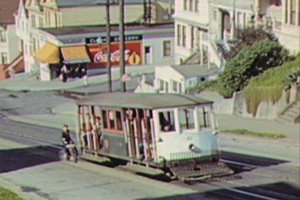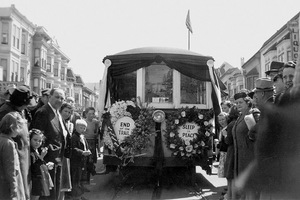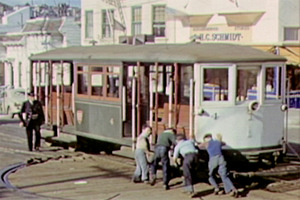As part of our mission, Market Street Railway creates displays on-board the historic streetcars to educate San Franciscans and visitors on interesting aspects of the city’s transit history. We call it the Museums in Motion project. This is an online version of one of those displays.
Today, the electric streetcars of the F‑line take you out Market Street to the Castro. But before there were streetcars on Market, people traveled from the Ferry Building to Castro by cable car! And then they could continue on the same cable car over the hill on Castro all the way to 26th Street in Noe Valley.
From 1883 until the great earthquake and fire of 1906, cable cars ran on Market Street. Aside from the Castro cable car line, underground cables pulled cars along Market on other routes that branched off at McAllister, Hayes, Haight, and Valencia Streets. The Market Street cable cars were larger than the surviving Powell Street and California Street cable cars, but they weren’t any faster.
After the quake, speedier electric streetcars took over those old Market Street cable car routes, except for the portion of the Castro route from 18th to 26th Street. That isolated stretch of the ‘Castro Cable’ was too steep for streetcars and carried on as a quiet neighborhood shuttle line that Noe Valley people took to reach the 8-line streetcar near the Castro Theater to continue their trip downtown. The Castro Cable lasted until 1941, when it was replaced by an extension of the 24-line bus.
And those original Market Street cable car routes that converted to electric streetcars in 1906? After World War II, they became electric trolley bus lines, the 5, 7, and 21 among them. The 8-Castro line streetcar converted to trolley bus as well, but then went back to the future in 1995, when it became an electric streetcar again: today’s F-line!

Cable cars on Castro Street are now just a fond but distant memory. That little neighborhood line was literally and figuratively a long way from today’s surviving cable car routes. Even before World War II, the Powell Street and California Street cable car lines carried a lot of visitors to the city and got all the publicity. If you ran into a tourist on the Castro Cable, you could be pretty sure he or she was just lost.


By the way, the two streetcars you can find this display on are Muni car 1050 (the green and cream colored “wings” livery from the 1950’s) and Philadelphia car 1055 (also a green and cream design from the 50’s).
When the “F” line started, I made sure I took some photos of the 8 trolley bus line, knowing it was being phased out. Then in 2000, I photographed the 32 diesel bus. This was followed by the LA Metro 401 line, the Tri-Met 5 line (Portland OR) and a line in San Jose. There’s also the parking lot in Sacramento where one section was taken over by their light rail line. What a happy sight to see streetcars and LRV’s taking over former rubber-tire locations!
I don’t understand why this and other lines were discontinued when there was such a base of support in their respective communities? Every time there was a discontinuance, there were events and gatherings to mark the “end of service”. I can see them cutting lines that no one liked or used, but why a line that was well used and liked?
It wasn’t just the Castro cable line that was given a “wake” by the local community. About 11 years earlier, the Pacific Heights cable service received a big “farewell” party when its “dummy and trailer” operation was finally terminated in 1929 (as reported in “White Front Cars” by Charles Smallwood). A big reason for abandoning cable car lines was that they were (and are) labor intensive. Two person crews in the cars, and support personnel to lubricate and repair the numerous moving parts add up to major payroll expense. Once buses that could handle most of the hills of SF were available, the isolated cable lines were doomed. One can also ask that sometimes embarassing question: How many people in the crowds at the “wakes” actually rode the cars on a regular basis? There are many stories in railfandom about “last runs” where the passenger count was many times greater than the usual load.